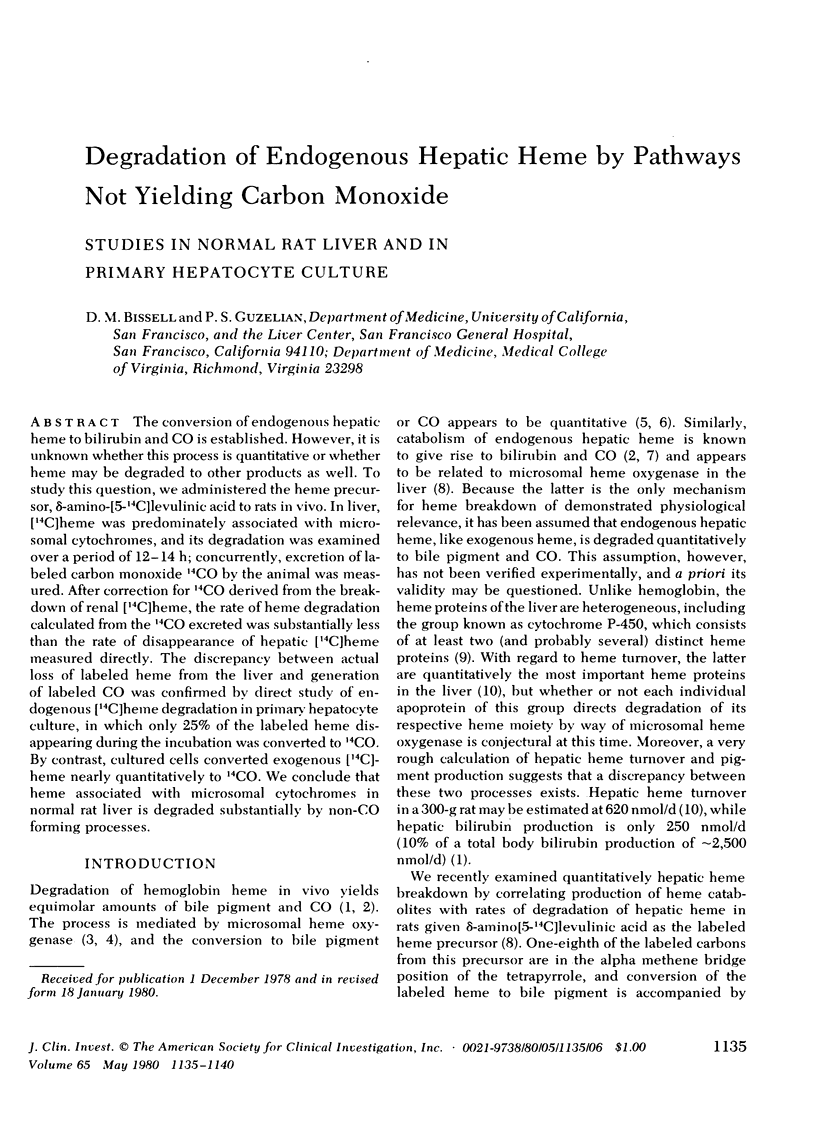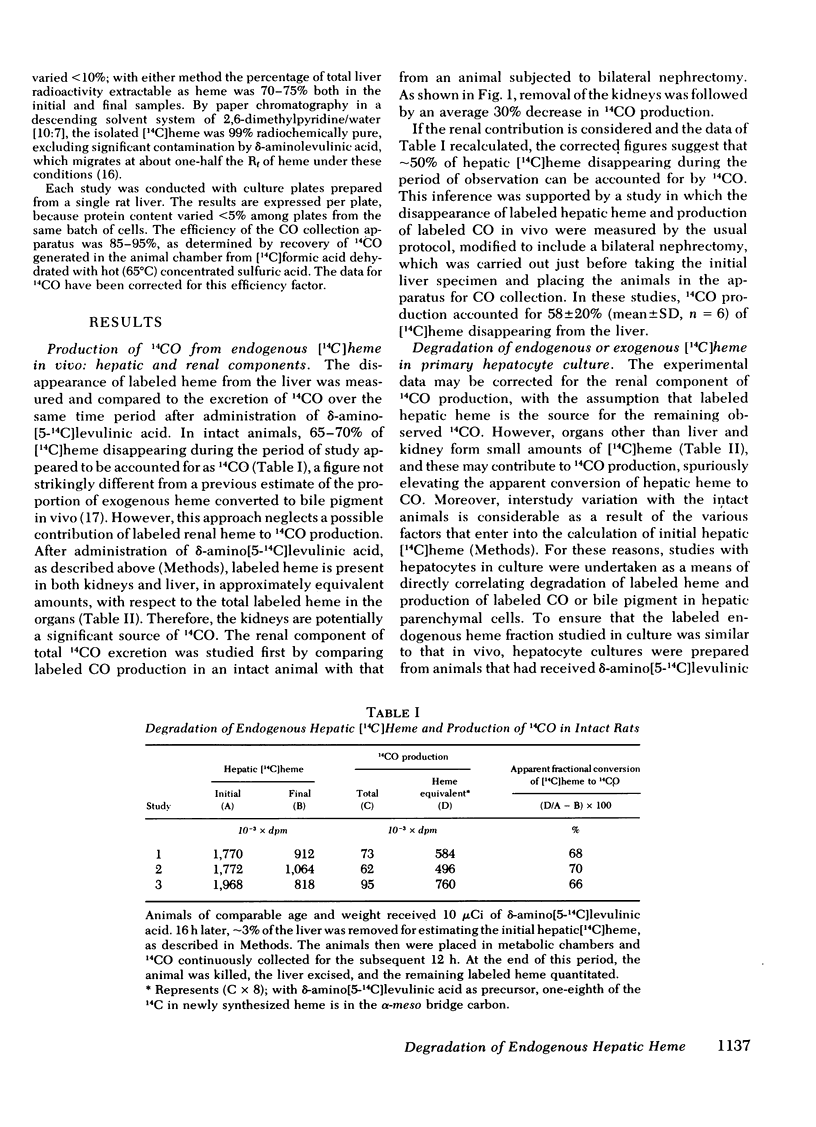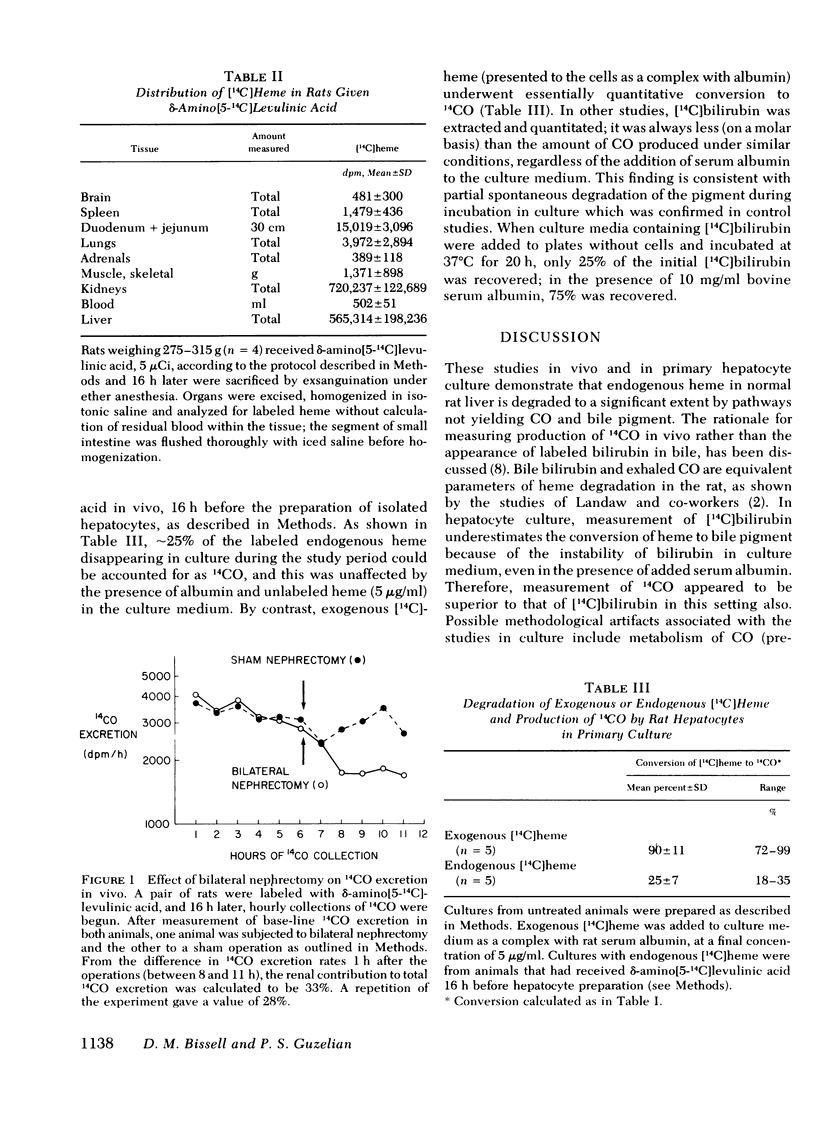Abstract
The conversion of endogenous hepatic heme to bilirubin and CO is established. However, it is unknown whether this process is quantitative or whether heme may be degraded to other products as well. To study this question, we administered the heme precursor, delta-amino-[5-14C]levulinic acid to rats in vivo. In liver, [14C]heme was predominately associated with microsomal cytochromes, and its degradation was examined over a period of 12--14 h; concurrently, excretion of labeled carbon monoxide 14CO by the animal was measured. After correction for 14CO derived from the breakdown of renal [14C]heme, the rate of heme degradation calculated from the 14CO excreted was substantially less than the rate of disappearance of hepatic [14C]heme measured directly. The discrepancy between actual loss of labeled heme from the liver and generation of labeled CO was confirmed by direct study of endogenous [14C]heme degradation in primary hepatocyte culture, in which only 25% of the labeled heme disappearing during the incubation was converted to 14CO. By contrast, cultured cells converted exogenous [14C]heme nearly quantitatively to 14CO. We conclude that heme associated with microsomal cytochromes in normal rat liver is degraded substantially by non-CO forming processes.
Full text
PDF





Selected References
These references are in PubMed. This may not be the complete list of references from this article.
- Berk P. D., Rodkey F. L., Blaschke T. F., Collison H. A., Waggoner J. G. Comparison of plasma bilirubin turnover and carbon monoxide production in man. J Lab Clin Med. 1974 Jan;83(1):29–37. [PubMed] [Google Scholar]
- Bissell D. M. Formation and elimination of bilirubin. Gastroenterology. 1975 Aug;69(2):519–538. [PubMed] [Google Scholar]
- Bissell D. M., Hammaker L. E. Cytochrome P-450 heme and the regulation of hepatic heme oxygenase activity. Arch Biochem Biophys. 1976 Sep;176(1):91–102. doi: 10.1016/0003-9861(76)90144-2. [DOI] [PubMed] [Google Scholar]
- Bissell D. M., Hammaker L. E., Meyer U. A. Parenchymal cells from adult rat liver in nonproliferating monolayer culture. I. Functional studies. J Cell Biol. 1973 Dec;59(3):722–734. doi: 10.1083/jcb.59.3.722. [DOI] [PMC free article] [PubMed] [Google Scholar]
- Bissell D. M., Hammaker L., Schmid R. Hemoglobin and erythrocyte catabolism in rat liver: the separate roles of parenchymal and sinusoidal cells. Blood. 1972 Dec;40(6):812–822. [PubMed] [Google Scholar]
- COBURN R. F., WILLIAMS W. J., FORSTER R. E. EFFECT OF ERYTHROCYTE DESTRUCTION ON CARBON MONOXIDE PRODUCTION IN MAN. J Clin Invest. 1964 Jun;43:1098–1103. doi: 10.1172/JCI104994. [DOI] [PMC free article] [PubMed] [Google Scholar]
- De Matteis F., Gibbs A. H., Unseld A. Loss of haem from cytochrome P-450 caused by lipid peroxidation and 2-allyl-2-isoprophylacetamide. An abnormal pathway not involving production of carbon monoxide. Biochem J. 1977 Dec 15;168(3):417–422. doi: 10.1042/bj1680417. [DOI] [PMC free article] [PubMed] [Google Scholar]
- Guzelian P. S., Bissell D. M. Effect of cobalt on synthesis of heme and cytochrome P-450 in the liver. Studies of adult rat hepatocytes in primary monolayer culture and in vivo. J Biol Chem. 1976 Jul 25;251(14):4421–4427. [PubMed] [Google Scholar]
- Guzelian P. S., Bissell D. M., Meyer U. A. Drug metabolism in adult rat hepatocytes in primary monolayer culture. Gastroenterology. 1977 Jun;72(6):1232–1239. [PubMed] [Google Scholar]
- Hrycay E. G., O'Brien P. J. Cytochrome P-450 as a microsomal peroxidase utilizing a lipid peroxide substrate. Arch Biochem Biophys. 1971 Nov;147(1):14–27. doi: 10.1016/0003-9861(71)90304-3. [DOI] [PubMed] [Google Scholar]
- Jeffery E., Kotake A., Azhary R. E. Effects of linoleic acid hydroperoxide on the hepatic monooxygenase systems of microsomes from untreated, phenobarbital-treated, and 3-methylcholanthrene-treated rats. Mol Pharmacol. 1977 May;13(3):415–425. [PubMed] [Google Scholar]
- Jones E. A., Bloomer J. R., Berlin N. I. The measurement of the synthetic rate of bilirubin from hepatic hemes in patients with acute intermittent porphyria. J Clin Invest. 1971 Nov;50(11):2259–2265. doi: 10.1172/JCI106723. [DOI] [PMC free article] [PubMed] [Google Scholar]
- Kirshenbaum G., Shames D. M., Schmid R. An expanded model of bilirubin kinetics: effect of feeding, fasting, and phenobarbital in Gilbert's syndrome. J Pharmacokinet Biopharm. 1976 Apr;4(2):115–155. doi: 10.1007/BF01086150. [DOI] [PubMed] [Google Scholar]
- Landaw S. A., Callahan E. W., Jr, Schmid R. Catabolism of heme in vivo: comparison of the simultaneous production of bilirubin and carbon monoxide. J Clin Invest. 1970 May;49(5):914–925. doi: 10.1172/JCI106311. [DOI] [PMC free article] [PubMed] [Google Scholar]
- Landaw S. A. Quantitative recovery of 14 C-labeled carbon monoxide ( 14 CO) from viable heme-labeled red blood cells in the rat. Blood. 1972 Aug;40(2):257–260. [PubMed] [Google Scholar]
- Maines M. D., Anders M. W. Characterization of the heme of cytochrome P-450 using gas chromatography-mass spectrometry. Arch Biochem Biophys. 1973 Nov;159(1):201–205. doi: 10.1016/0003-9861(73)90445-1. [DOI] [PubMed] [Google Scholar]
- OSTROW J. D., HAMMAKER L., SCHMID R. The preparation of crystalline bilirubin-C14. J Clin Invest. 1961 Aug;40:1442–1452. doi: 10.1172/JCI104375. [DOI] [PMC free article] [PubMed] [Google Scholar]
- OSTROW J. D., JANDL J. H., SCHMID R. The formation of bilirubin from hemoglobin in vivo. J Clin Invest. 1962 Aug;41:1628–1637. doi: 10.1172/JCI104620. [DOI] [PMC free article] [PubMed] [Google Scholar]
- Ortiz de Montellano P. R., Mico B. A., Yost G. S. Suicidal inactivation of cytochrome P-450. Formation of a heme-substrate covalent adduct. Biochem Biophys Res Commun. 1978 Jul 14;83(1):132–137. doi: 10.1016/0006-291x(78)90407-2. [DOI] [PubMed] [Google Scholar]
- Robinson S. H., Tsong M., Brown B. W., Schmid R. The sources of bile pigment in the rat: studies of the "early labeled" fraction. J Clin Invest. 1966 Oct;45(10):1569–1586. doi: 10.1172/JCI105463. [DOI] [PMC free article] [PubMed] [Google Scholar]
- SNYDER A. L., SCHMID R. THE CONVERSION OF HEMATIN TO BILE PIGMENT IN THE RAT. J Lab Clin Med. 1965 May;65:817–824. [PubMed] [Google Scholar]
- Schacter B. A., Marver H. S., Meyer U. A. Heme and hemoprotein catabolism during stimulation of microsomal lipid peroxidation. Drug Metab Dispos. 1973 Jan-Feb;1(1):286–292. [PubMed] [Google Scholar]
- Schwartz S., Cardinal R. Non-hemoglobin heme intermediates in the biosynthesis of bile pigments. Medicine (Baltimore) 1967 Mar;46(2):73–81. doi: 10.1097/00005792-196703000-00001. [DOI] [PubMed] [Google Scholar]
- Sinclair P., Gibbs A. H., Sinclair J. F., de Matteis F. Formation of cobalt protoporphyrin in the liver of rats. A mechanism for the inhibition of liver haem biosynthesis by inorganic cobalt. Biochem J. 1979 Mar 15;178(3):529–538. doi: 10.1042/bj1780529. [DOI] [PMC free article] [PubMed] [Google Scholar]


